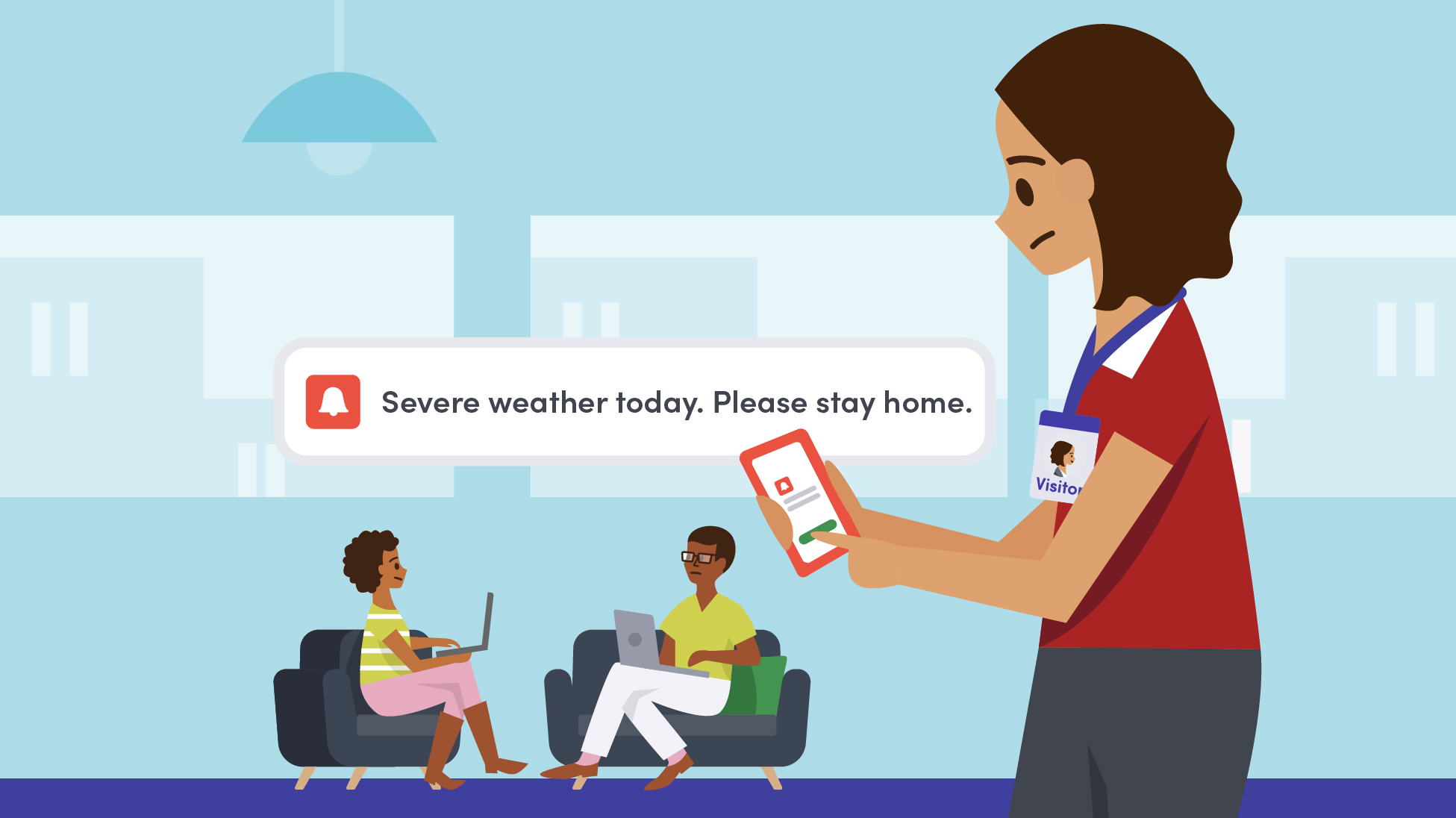When an emergency strikes, every second counts. The ability to respond swiftly to critical situations—whether it's a weather-related emergency, a security threat, or a power outage—is an absolute must in today’s workplace. Timely and clear internal communication helps keep both onsite and remote employees informed and safe.
That’s where Envoy’s Emergency Notification templates come in. These preconfigured messages enable you to quickly set up your emergency notification plan so you can deliver the right information to the right people. In this guide, we’ll walk you through best practices for using messaging templates with Envoy, from setting them up to sending real-time alerts.
How do emergency notification templates work with Envoy?
Emergency notification templates are prebuilt messages that help streamline emergency mass communication across one or more channels. Companies typically set up templates for common incidents so that when action is needed, admins can quickly choose and send the right message.
Templates consist of a fixed structure with variables like incident type, location, and date, which are automatically populated when an alert is triggered. In Envoy, admins can modify default templates or create their own based on specific incidents like fires or severe weather.
Examples of emergency notification messaging templates
Each template contains placeholders (e.g., [Location]) that are automatically filled based on the specific incident. Be sure to use clear and direct language and avoid jargon or unnecessary details that could delay response times.
{{protip-4}}
Why use messaging templates for emergency communication?
Envoy’s Emergency Notification Messaging Templates help businesses respond to crises quickly and effectively. By setting up clear, pre-written alerts, your organization can minimize confusion, ensure compliance, and keep employees and visitors safe.
- Speed and efficiency. Emergencies demand fast action. Templates eliminate the need to compose messages from scratch, ensuring that notifications go out immediately with critical details already in place.
- Consistency in communication. Pre-written messages ensure that every alert has all the necessary details, a professional tone, and is aligned with company protocols, reducing confusion during high-stress situations.
- Multi-channel delivery. With Envoy, messages can be sent via SMS, email, Slack, Microsoft Teams, and push notifications in Envoy Mobile, reaching employees and visitors no matter where they are.
- Compliance with safety regulations. Employers must comply with regulations like the Occupational Safety and Health Administration (OSHA) and California’s Senate Bill (SB 553), which mandate clear and timely emergency communication. Templates help meet these requirements while maintaining digital logs of emergency response efforts, which are critical for audits and compliance tracking.
Tips for setting up emergency notifications with Envoy
1. Predefine incident categories and templates
Streamline your emergency response by setting up predefined categories (e.g., “Fire,” “Weather Alert,” “IT Outage”) and customizable message templates in Envoy. Use placeholders like {{location}} or {{time}} for real-time details, and test your setup to ensure smooth execution.
{{protip-1}}
2. Integrate with your directory services
Syncing your directory with Envoy helps you keep employee contact details up to date. By enabling SCIM syncing, you can automatically update employee info and create department-level recipient groups. That way, you can send specific messages to targeted groups. Connect your directory service (e.g., Okta) in Envoy’s Integration Settings, and it will handle the rest.
{{protip-2}}
3. Implement multi-channel alerts
In Envoy’s admin settings, you can configure the system to send emergency alerts via SMS, email, or both. You can also set up push notifications for users who have installed the Envoy mobile app.
How it works: Navigate to the Notifications section in the Envoy dashboard. Select the types of notifications you want to send (e.g., SMS, email, and/or push notifications) and configure the message templates for each type of alert. This ensures notifications are sent through all selected channels when an emergency occurs.
4. Segment and customize recipient groups
With SCIM employee groups, you can automatically sync department, division, or organization attributes from your identity provider (IdP) to Envoy in order to send targeted emergency notifications. These predefined groups ensure fast, accurate communication with the right people when it matters most.
{{protip-3}}
5. Test regularly and include drills
Make sure your messages reach all intended devices and channels. Envoy lets admins test alerts with specific groups, like your security team. Also, don’t forget to train your employees—it’s the law. California’s SB 553 requires businesses to provide employees with periodic training on what to do during an emergency.
6. Double-check that employees are all set
Use regular prompts and reminders to encourage employees to update their contact details (e.g., phone numbers), and enable desktop notifications for emails and push notifications on the Envoy app.
How it works: Use the Envoy mobile app to prompt users to verify their contact information upon login or implement recurring push notifications reminding employees to keep their details updated in the directory.
—
If you haven’t set up your emergency notification templates yet, log into your Envoy dashboard and start configuring them today. Need help? Check out our help center for step-by-step instructions.
For a step-by-step breakdown, check out our help center article.
For a detailed setup guide, take a look at our help center article.
For more info, check out our help center article.
- Fire evacuation.” Emergency Alert: Fire detected at [Location]. Evacuate the building immediately using the nearest exit. Meet at the designated assembly point.”
- Severe weather. “Severe Weather Warning: Due to [weather condition], please stay home today. Office [Location] is closed until further notice.”
- Lockdown notification. “Emergency Alert: Security threat reported at [Location]. Please secure your area and follow lockdown procedures.”
- IT outage. “We are experiencing an IT outage affecting [system name]. Our team is working on a resolution. Estimated resolution time: [Timeframe].”
Read more
Searching for a visitor management solution? Learn what to look out for and how to choose the best tech for your team.
Managing your space well doesn’t have to be difficult. But if you want to be successful, you need the right approach.
A well-run workplace can set your team up for success. Learn why workplace management matters and how to do it right.
Workplace security is critical to the future of your business. Learn why it matters, what threats to watch for, and how to strengthen your workplace security plan.
In this post, we’ll explore what workplace compliance is and how to build a compliance culture for your organization.
With more folks sending personal packages to the workplace, having a sound mailroom management system in place is key.








